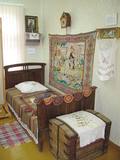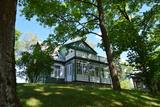| Nr | Name | Beschreibung |
|---|---|---|
|
Boutique Hotel Altenburg mājo vairāk nekā divus gadsimtus senā koka ēkā, kas ir viena no ievērojamākajām Talsu vecpilsētas arhitektūras pērlēm. Kādreiz gandrīz pamesta un nolaista, šī ēka piedzīvojusi rūpīgu restaurāciju, atgūstot savu šarmu un vēsturisko stāju. Viesnīcas interjers ir harmonisks līdzsvars starp wabi-sabi pieeju, rustikālu eleganci un dabiskām faktūrām — te dominē koks, akmens un lins. Katrā telpas detaļā jūtama pārdomāta izvēle un cilvēciska piesaiste. Dizaina koncepciju radījis Roalds Cinis, bet apdari papildina vietējo meistaru roku darbs: “Ciparnīcas” keramikas trauki, darināti pledi un Latvijas tējas. Viesiem piedāvāti seši divvietīgi numuri, koplietošanas virtuve un mājīgs salons, kā arī klusas lasīšanas vietas ar grāmatām un mazs vīna pagrabiņš. Boutique Hotel Altenburg atspoguļo lēnās dzīves filozofiju — tā ir vieta nesteidzīgai atpūtai, klusumam un pievēršanās sev. |
||
|
The History Museum of Malta. Exposition „History of Malta parish: from
Rozentova and Borovaja to Malta”. We offer household items, tools of trade,
works of art, collection of paper money and coins. Excursion outside the museum
„At the cross-roads of Malta”.
Working hours: Mon– Fri : 9.00 – 17.00, Sat., Sunday : closed |
||
|
Natālija Rutule owns this workshop in the Alsunga Museum building. She teaches master classes in preparing various health and beauty products. A sound workshop offers a chance to listen to the peaceful sounds of gongs, bells and other instruments. |
||
|
Eine aus Holz von den einheimischen Handwerkern nach der Finanzierung der Grafen Plater gebaute Kirche stammte von 1655 bis 1658 als eine nicht große einschiffige Basilika. Das einzigartige kulturhistorische Denkmal gilt als eine der ältesten Holzkirchen in Lettgallen. Die Schnitzerei des Zentralaltars in den Formen des Barocks wurde von den Meistern der Schnitzereischule von Stelmuže erschaffen. Im Seitenaltar befindet sich das Bild aus dem 18. Jahrhundert “St. Maria Magdalena”. Die Kirche wurde 1698 auf den jetzigen Platz – am rechten Daugava-Ufer befördert. Das Gebäude wurde mehrmals – 1890 und 1918 erneuert. Um die Kirche herum befindet sich einen Steinzaun aus dem Ende des 17. Jahrhunderts mit einem separat stehenden Glockenturm aus der Mitte des 19. Jahrhunderts, der 2002 restauriert wurde. Gemäß verschiedenen Informationsquellen kann man behaupten, dass die Gemeinde von Indrica die älteste in Lettgallen ist. |
||
|
Uļjanova Old-Believers Prayer House was built in 1875. The house
is a modest building where everyone can come to confess. The Prayer House is not rich in decorations.
|
||
|
Das Café befindet sich im Zentrum von Jekabpils. Hier werden Pizzen, Brötchen, Kuchen, Torten und Kringel gebacken, sowie geräuchertes Fleisch, Delikatessen aus Hirsch- und Wildschweinfleisch, Produkte der lokalen Heimarbeiter und Bauer angeboten. |
||
|
Der älteste und größte Kurort Litauens (seit 1794). Mikroklima (Luft der Umgebungswälder), salzhaltigee Quellen, Heilschlamm. Die Altstadt ist ein städtebauliches Denkmal. |
||
|
Das Restaurant befindet sich im Zentrum von Talsi, am Rande der Lielā Straße. Hier kann man Gerichte aus dem Kochbuch der Großmutter, aus der Küche der Welt und ein breites Angebot an Weinen bestellen. Das Restaurant arbeitet mit lokalen Bauern zusammen. Lettische Küche: Sauerkrautsuppe mit gebratenen Schweinerippen, Graupensuppe mit Waldpilzen, Hering mit Quark, Graupengrütze, geschmorter Braten mit geschmortem Sauerkraut, Lammfleischbraten, Quarkfladen, in Lettland hergestellte Biersorten. |
||
|
Die Käsespezialitäten werden nach alten, in Lettland verwendeten Rezepten hergestellt. Wie vor 100 und mehr Jahren wird Handarbeit angewendet. Die Erzeugnisse haben das Qualitätszeichen „Grüner Löffel” erhalten. Frischer Käse kann geräuchert werden. Es werden Betriebsbesichtigungen angeboten. Annahme von Bestellungen und Lieferung der Fertigproduktion. |
||
|
Das Dorf befindet sich 7km nördlich des Zentrums von Vecpiebalga. Hier kann man für die Gegend typische Landhöfe und Handwerkerhäuser des 19.Jh. mit Arbeitsgeräten und Gegenständen des täglichen Lebens besichtigen, auch eine kürzlich erneuerte Windmühle. Im Dorf leben auch heute noch einige Bewohner. Es empfiehlt sich, das Museum mit einem ortskundigen Führer zu besuchen. |
||
|
Vilsandi bāka sāka darboties 1809. g. Ja uzmanīgi palūkojas uz torņa, labi redzams, ka tas ir vairākas reizes paaugstināts. Tagadējās bākas augstums ir 37 m, bet gaismas elements atrodas 40 metrus virs jūras līmeņa. Bāka ar apkārtējām ēkām ir apskatāma tikai no ārpuses. Ja pa Vilsandi arhipelāgu ceļo ar jūras laivu vai citu peldlīdzekli, tad bāka kalpo kā ļoti labs orientieris daudzo salu, līču un pussalu labirintā. No bākas redzama jūras krastā uzceltā glābšanas stacija. Pateicoties tai, Vilsandi ūdeņos izglābti 29 cilvēki, 2 suņi un 1 kaķis. Tā stāsta vietējie. |
||
|
Hauptstadt von Hiiumaa. |
||
|
Die museale Gedenkstätte für A. Baranauskas und A. Vienuolis-Žukauskas wurde 1927 begründet. Hier wird Material gesammelt, archiviert und gezeigt, welches die Kultur und Literatur der Gegend um Anykščiai, die Geschichte, die Entwicklung von Landwirtschaft und Technik in der Region zeigt. Die Besucher können das ganze Jahr über durch die Hügel des Schriftstellergedächtnisparks spazieren. |
||
|
Der Hof befindet sich in schöner, ruhiger Lage, an einem Teich, der mit seinem Fischreichtum jedes Anglerherz erfreut. Als Gästehaus dient der ehemalige, 120 Jahre alte Speicher, in dem sich jetzt die Schlafräume, die Küche und die Sauna befinden. |
||
|
Neliels, bet ļoti ainavisks un ar lieliem laukakmeņiem klāts
zemesrags. No raga iztālēm redzamas Veczemju
klintis.
|
||
|
Eine Floßhauptstadt Lettlands mit dem jährlichen Flößerfest im Mai. |
||
|
Die Scheune wurde in der zweiten Hälfte des 19. Jh. gebaut. Im Gebäude gibt es eine ständige Ausstellung. Darin kann man sehen, wie auf dem Landgut einst die Bodenbestellung und das Brotbacken erfolgten. Brotbacken auf Bestellung. |
||
|
Before its flooding, the canyon of the Daugava River between Pļaviņas and Koknese was one of the most outstanding and beautiful parts of the Baltic terrain, and Oliņkalns hill was one of the largest castle hills in Latvia. The Andrejs cliff as up to 20 metres high, and it was part of the Daugava canyon. Before the area was flooded because of the construction of the Pļaviņas hydroelectric power plant, there were rapids near the hill that made it hard for rafters to sail down the river. Today it is a small island in the reservoir of the plant (it can be seen from the side of the Rīga-Daugavpils highway (A6) opposite Stukmaņi). It is separated from the shore by 300 metres of river, under which the Dūņas valley is now resting. A small part of the ramparts of the castle hill can still be seen on the island along with the ruins of an open-air stage and a few metres of the dolomite cliff that have remained above water. It is thought that the Alene castle was on the hill in the 13th century. Latvian mountain climbers installed a memorial stone in 1998 opposite Oliņkalns hill. |
||
|
Auf dieser Route geht es von der lettische Hauptstadt nach Kaunas, der zweitgrößten Stadt in Litauen, wobei viele schöne ländliche Gärten besichtigt werden können. Der Ziergarten der Familie Klūgs ist für seine Begonien berühmt. Im Institut für Gartenbau Dobele gibt es eine Kollektion von über 200 Fliedersorten zu sehen. Der Garten der schönen und praktischen Ideen ist stolz auf seine reichhaltige Kollektion an Nadelgehölzen und die Hausherren bieten an, Gewürze, getrocknete Früchte und Beeren zu verkosten. Der Hof „Rūķīšu tējas“ („Zwergentee“) ist einer der größten lettischen Produzenten von Arzneipflanzen (darunter Sonnenhut, Ringelblume, Kamille). In Kronauce stehen, zumindest in der Saison, der Pfingstrosengarten von Andris Berkins und der Tulpengarten „Viestardi“ auf dem Programm. Nächster Halt ist der Hof „Droši vesels“ („Mutig gesund“), wo Gemüse angebaut wird und wo aus Heilpflanzen Salben hergestellt werden. Die Besucher des „Minzehäuschens“ haben die Möglichkeit, Pfefferminztee, Plätzchen und Honig mit Minze und Minzesirup zu probieren. Im Gut Blankenfelde kann man eine einzigartige Glockensammlung besichtigen und natürliche Säfte, Sirups und diverse eingelegte Leckereien, alle vor Ort gefertigt, verkosten. In Litauen angekommen, steht der Besuch von Joniškis auf dem Programm, wo der Besuch der roten und weißen Synagoge, der Mariä-Himmelfahrt-Kirche und des kulturgeschichtlichen Museums empfohlen wird. Das Gut Jakiškiai ist bisher nicht renoviert, was dazu führt, dass viele Elemente authentisch erhalten sind, so z.B. Öfen, Türschlösser, Treppen und Türen. Im Museum der weißen Kräuter werden über 30 Pflanzenarten und -sorten angebaut. Der Botanische Garten der Universität Šiauliai zeigt das Erbe alter Kulturpflanzen und Vorgärten nach den Traditionen der Zwischenkriegs- und der Nachkriegszeit. Das Gut Burbiškis ist bekannt für sein jährliches Tulpenfest im Landschafts- und Skulpturenpark. Das ethnographische Dorfmuseum Kleboniškiai zeigt für die Region typische Häuser und Höfe. Das Gut Baisogala war einst königliche Domäne und gehörte direkt dem litauischen Großfürsten. Sein 12 Hektar großer Park gehört zu den schönsten in Litauen. Im Museum für den litauischen Dichter Mačiulis-Maironis gibt es zwei historische, dörfliche Obstgärten. Auf dem Hof „Garsi Tyla“ kann man auf dem Hof erzeugte „glückliche Lebensmittel“ kaufen und in dem alten 100-jährigen Garten spazieren und die Heilpflanzenbeete besichtigen. Das Litauische Institut für Gartenbau in Babtai ist nicht nur wissenschaftlich tätig, sondern auch in die Zucht involviert. Man kann hier daher viele neue Sorten von Obstbäumen und Beerensträuchern erwerben sowie Obst und Gemüse in der Saison. Im Hof und Park von Professor Tadas Ivanauskas namens Obelynė kann man eine Sammlung von etwa 300 Arten und Formen von Gehölzen besichtigen, hier wächst auch einer der ältesten Ginkgos in Litauen. In Kaunas kann man den ältesten Apfelbaum des Landes, einen Holzapfel, besichtigen. dieser hat mit einem Alter von fast 360 Jahren eine Höhe von 8 m und einen Brusthöhendurchmesser vom 2,85 m. Der botanische Garten der Vytautas-Magnus-Universität in Kaunas verfügt über die größte Orangerie in Litauen und zahlreiche Unikate sowie eine umfangreiche Blumensammlung. Die Reiseroute endet in Kaunas, das von 1920 bis 1939 einstweilige Hauptstadt von Litauen war. |
||
|
Vijciema čiekurkalte ir viena no retajām vēsturiskajām čiekurkaltēm Eiropā, kas celta 19. gadsimtā, un ir ne vien teicami saglabājusies līdz mūsdienām, bet arī, izmantojot vairāk nekā 100 gadus senas iekārtas, čiekurkaltē arvien tiek žāvēti čiekuri, lai iegūtu augstas kvalitātes meža sēklas. Pateicoties ēkas bagātajai vēsturei un senajām čiekuru žāvēšanas tradīcijām, Vijciema čiekurkalte ir iecienīts tūristu objekts, kas piesaista vēstures, dabas un tehnoloģiju interesentus. Vijciema čiekurkaltes apmeklētājiem ir iespēja doties izzinošā ekskursijā gan individuāli, gan grupās. Ekskursijas laikā ir iespēja atklāt čiekurkaltes vēsturi, skatīt čiekuru apstrādes cikla demonstrāciju, kā arī uzzināt, kur, kā un kāpēc čiekuri tiek lasīti. Ekskursijas un individuālos apmeklējumus iepriekš jāpiesaka, zvanot 26478620. Cena
|
||





















